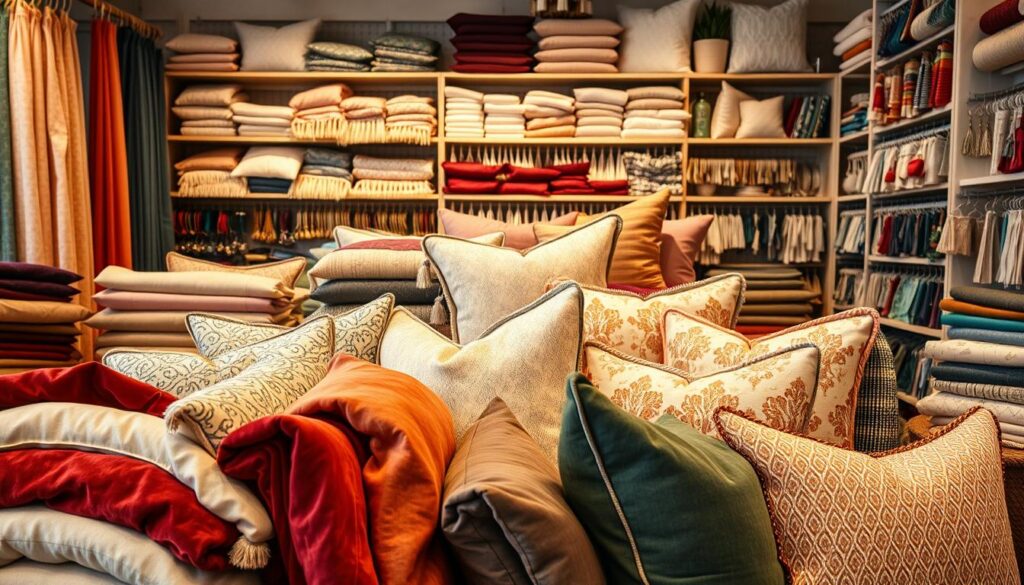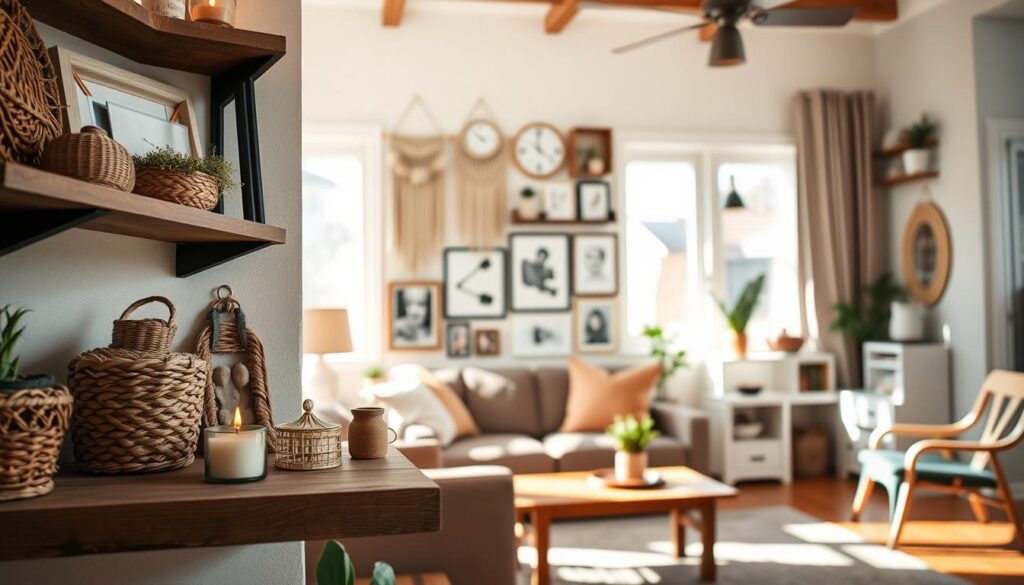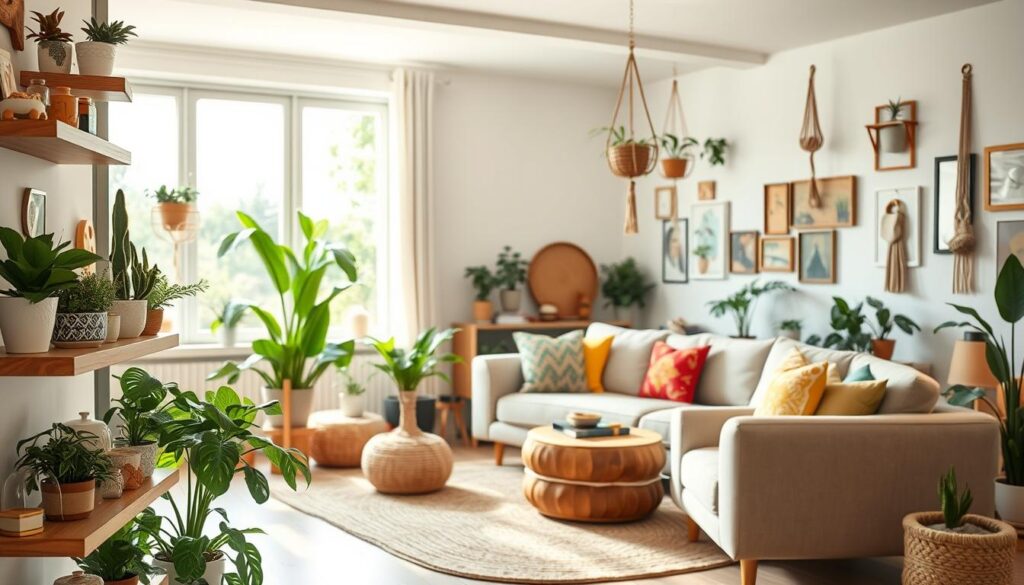Did you know a simple decor change can boost your mood and productivity? With DIY projects, you can turn your home into a stylish, personalized space.
We think making your home look new doesn’t have to cost a lot. By using interior design tips and doing home decor projects, you can create a beautiful, unique space that shows off your personality.
We aim to show you DIY home interior design ideas that are affordable and fun. Whether you want to change one room or your whole house, we’ve got the inspiration and advice you need.
Key Takeaways
- Discover how to give your space a personalized touch.
- Learn cost-effective ways to refresh your decor.
- Explore various DIY projects to enhance your living area.
- Understand the benefits of engaging in DIY design projects.
- Get inspired with creative ideas for your next home decor project.
Understanding DIY Home Interior Design
DIY home interior design is a mix of creativity, practicality, and saving money. It’s great for homeowners who want to make their homes unique without spending a lot. By doing DIY projects, you can make your space your own while keeping costs down.
What is DIY Home Interior Design?
DIY home interior design means designing and decorating your home by yourself. It lets you take charge of your home’s look, from picking materials to doing the work. DIY decorating ideas can be anything from painting walls to building furniture or redoing rooms.
Benefits of DIY Design Projects
DIY design projects have many advantages. They can be budget-friendly and let you create a space that’s truly yours. By choosing DIY, you can:
- Save money by avoiding professional fees
- Learn new skills and gain experience in home renovation
- Make your space exactly how you want it
- Feel proud of creating something yourself
Let’s look at how DIY can save you money and let you be creative:
| Project | DIY Cost | Professional Cost |
|---|---|---|
| Painting a Room | $100-$300 | $500-$1,000 |
| Building a Coffee Table | $50-$150 | $300-$800 |
| Renovating a Kitchen | $1,000-$3,000 | $5,000-$15,000 |
The table shows DIY can save a lot of money. This makes budget-friendly home design possible for many. By going DIY, you can make your home creative and personal.
Getting Started with DIY Design
The first step in making your home look new is to check your space and set a budget. This step is key to making your DIY projects look good and not cost too much.
Assessing Your Space
Looking at your space means more than just measuring rooms. It’s about how you use each area and what makes it work well. Think about the layout, light, and any special features.
When you assess your space, remember these points:
- The purpose of each room and how it is used
- The condition and style of existing furniture and decor
- Any architectural features that could influence your design decisions
Knowing these things helps you see what needs fixing and where you can add DIY room decor. This way, you can make your home look better.
Setting a Budget
Having a budget is key for DIY projects. It helps you decide where to spend more and where to save. This way, your projects stay within your means. Think about the cost of materials, tools, and any help you might need.
| Budget Category | Estimated Cost | Tips for Saving |
|---|---|---|
| Materials | $100-$500 | Shop during sales or use recycled materials |
| Tools | $50-$200 | Borrow from friends or invest in multi-purpose tools |
| Professional Services | $200-$1000 | Limit hiring professionals to only essential tasks |
By carefully looking at your space and setting a budget, you can do do it yourself home projects. You’ll get stylish interior design without spending too much.
Choosing a Design Style
The key to a successful DIY design project is picking a style that fits your lifestyle. Your home’s style is about looks and function. It should be comfortable and work well for you.
When it comes to DIY decorating ideas, there are many choices. Each style has its own look. To choose well, let’s look at some popular styles and what makes them special.
Popular Design Styles
There are many design styles to match different tastes. Here are a few:
- Modern Minimalist: Simple, clean, and little decoration.
- Farmhouse: Rustic, vintage, natural, and cozy.
- Industrial: Exposed brick, metal, and reclaimed wood for a raw feel.
- Bohemian: A mix of vintage and global, vibrant and eclectic.
| Design Style | Key Features | Ideal For |
|---|---|---|
| Modern Minimalist | Simple, clean lines, minimal decor | Those who prefer a clutter-free environment |
| Farmhouse | Rustic, vintage, natural materials | Families and those who love a cozy atmosphere |
| Industrial | Exposed brick, metal accents, reclaimed wood | Urban dwellers and those who like a raw, edgy look |
How to Select the Right Style for Us
Choosing the right style means thinking about your lifestyle and home. Here are some interior design tips to help:
First, think about how you use your space. A big family might like Farmhouse for its coziness. Modern Minimalist is great for those who like things tidy.
Second, think about what you like. If you love vintage and natural, Farmhouse or Bohemian might be for you. Industrial is perfect for a modern, urban look.
Lastly, mixing styles can create a unique look that shows your personality. The key is to mix well.
By following these home decor projects tips, you can make a home that’s both beautiful and practical.
Color Schemes That Inspire
Color can change a room’s feel, making it a key part of creative home makeover projects. The colors we pick for walls, furniture, and decor affect our mood and well-being.
The Psychology of Color
Different colors make us feel different ways. Blue can calm us, while red energizes. Knowing this can help you pick the right colors for your home.
Think about the room’s purpose when picking colors. Bedrooms might need calming colors like light blue. Home offices might do better with colors like orange to boost energy.
Tips for Choosing Colors
Choosing the right colors can be tough, but here are some tips:
- Start with a neutral base: Use neutral colors for walls and big furniture. This lets you add color with decor and accessories.
- Consider the natural light: See how light changes the colors in your room. This ensures your colors look good at all times.
- Use the 60-30-10 rule: Choose a main color for 60% of the room, a secondary color for 30%, and an accent color for 10%. This creates a balanced look.
- Test the colors: Paint samples on walls or use swatches. This helps you see how colors will look before you decide.
Understanding color psychology and using these tips can lead to a budget-friendly home design that inspires. Whether you’re doing a full DIY home interior design project or just one room, the right colors make a big difference.
Furniture Layout and Arrangement
Creating a beautiful and functional space needs careful furniture arrangement. When we think about DIY room decor, we often focus on looks. But, the way we arrange our furniture is key for a stylish interior design.
Maximizing Space Efficiency
Maximizing space is a crucial part of furniture layout. We must think about the room’s flow and ensure easy movement. Here are a few tips to help you:
- Measure your room and furniture to scale before deciding on a layout.
- Choose multi-functional furniture pieces that serve more than one purpose.
- Consider the “traffic path” in your room and avoid blocking it with furniture.
Creating Focal Points
Creating focal points is also key in furniture arrangement. A focal point is an area that draws the eye and becomes the room’s center. To create a focal point, use a statement piece of furniture, a work of art, or any other visually appealing element. Here are some strategies for creating effective focal points in your do it yourself home projects:
- Use a bold, eye-catching color on one wall to create a focal point.
- Arrange your furniture in a way that leads the eye to the focal point.
- Balance your focal point with other elements in the room to avoid overwhelming the space.
By applying these principles, we can create a harmonious and functional space. This space will reflect our personal style and enhance our living experience.
Fabric Choices and Textiles
Fabrics and textiles are key in making our homes look good and feel cozy. The right fabrics can make a room feel more welcoming and personal.
Selecting the Right Fabrics
Choosing the right fabrics for our DIY projects is important. We need to think about durability, texture, and color. For example, a family room might need tough, stain-resistant fabrics. But a bedroom might be better with soft, comfy materials.
Here are some tips for picking the best fabrics:
- Think about the room’s purpose and the furniture.
- Consider the texture and how it feels.
- Match the colors to the room’s scheme.
- Remember, some fabrics need more care than others.

Incorporating Textiles for Comfort
Textiles do more than just look good; they make our homes comfortable. Soft furnishings like throw pillows, blankets, and rugs add warmth and coziness. They also help with sound and temperature, making spaces feel more welcoming.
Let’s see how different textiles can make a room more comfy:
| Textile | Comfort Aspect | Aesthetic Contribution |
|---|---|---|
| Throw Pillows | Softness, tactile comfort | Color, texture, pattern |
| Rugs | Warmth underfoot, noise reduction | Texture, color, defining spaces |
| Blankets | Warmth, coziness | Texture, color, layering |
By carefully choosing and using textiles, we can make our spaces beautiful, comfy, and inviting.
Lighting: Setting the Mood
Lighting is a key element in interior design. It can make or break a room’s feel. Good lighting adds warmth and invites you to relax, showing off your style.
Types of Lighting
Knowing the types of lighting is important. There are three main kinds: ambient, task, and accent lighting.
- Ambient Lighting: Lights up the whole room, making it safe to see and move around.
- Task Lighting: Focuses on areas for specific tasks, like reading or cooking.
- Accent Lighting: Highlights special features or objects, adding depth and interest.
DIY Lighting Solutions
DIY projects can create unique lighting effects. Here are some ideas to start with:
- Make pendant lights from mason jars or vintage bottles.
- Give old lampshades a new look with fabric, paint, or decoupage.
- Put LED strip lighting under furniture or along baseboards for a modern look.
Let’s compare different lighting options:
| Lighting Type | Energy Efficiency | Cost | Aesthetic Appeal |
|---|---|---|---|
| LED Lighting | High | Moderate to High | Modern and Sleek |
| Incandescent Lighting | Low | Low | Warm and Traditional |
| Fluorescent Lighting | High | Moderate | Cool and Utilitarian |
By using DIY lighting and knowing the different types, you can make a space that looks good and works well. It will be inviting and welcoming.
Wall Treatments and Decor
The walls in our homes are more than just boundaries. They’re chances to add character and style. When we explore DIY room decor, wall treatments play a big role in a space’s look.
Painting Techniques for Beginners
Painting is a great start for DIY home projects. It’s easy and can totally change a room. Start with a neutral base color to make it easy to add color with furniture and decor. Try ombre or stenciling for something interesting.
Alternative Wall Decor Ideas
There are many ways to decorate your walls beyond painting. Use textiles like tapestries or fabric panels for texture and warmth. Or, create a gallery wall with different frames to show off personal items or art.
For a big impact, try wall decals or wallpaper. They can make a bold statement or add a touch of elegance. The important thing is to try different things and see what looks best in your space.
Adding Personal Touches
Home decor is all about telling our stories. It makes every room a reflection of our memories and experiences. As we dive into DIY interior design, remember that the most important parts are those that connect with our personal history.
Incorporating Family Memories
Adding family memories to our spaces is very meaningful. Here are a few ways to do it:
- Displaying heirlooms or antique pieces that hold sentimental value.
- Creating a gallery wall featuring family photos and mementos.
- Using family recipes or historical documents as decorative elements.
By adding these personal touches, we make our homes more unique. We also keep our cherished memories alive.

DIY Art and Decorative Elements
DIY art and decor are great for adding a personal touch. Here are some ideas:
- Creating handmade artwork using personal symbols or motifs.
- Making decorative items from repurposed materials, such as turning old jars into vases.
- Crafting customized furniture pieces that reflect our personal style.
These DIY projects not only make our homes look better. They also give us a sense of pride and accomplishment in our creations.
Outdoor Spaces and Curb Appeal
Transforming our homes from the inside out is key. But, we shouldn’t forget about the outside. Our outdoor spaces are part of our living area. Making them better can really improve our home’s look from the street.
Designing a Welcoming Entryway
The entryway is the first thing people see when they come to our home. Making a good impression is very important. We can start by making sure our front door looks good. Maybe it needs a new paint job or a fresh door.
- Update your house numbers to a stylish and easy-to-read font.
- Add some welcoming decor, such as a wreath or a potted plant.
- Ensure your porch or entryway is well-lit.
By making these simple changes, we can make our entryway welcoming. It will set the tone for the rest of our home’s design.
DIY Landscaping Ideas
Landscaping is key for curb appeal. Creative landscaping can turn our outdoor space into a stunning area. Here are some DIY landscaping ideas to try:
- Start with a clean slate by clearing away any debris or weeds.
- Plant flowers or shrubs that are easy to maintain and match our home’s color.
- Think about adding a pathway or a small garden feature to add interest.
By using these DIY landscaping ideas, we can make our home’s curb appeal better. We’ll create a beautiful outdoor space that shows off our style.
As we keep looking for budget-friendly home design ideas, remember to improve our outdoor spaces. It’s a smart way to add value to our home without spending a lot. Whether it’s a small update to our entryway or a bigger landscaping project, our hard work will pay off.
Budget-Friendly Shopping Tips
Turning your home into a stylish space with DIY decor doesn’t have to cost a lot. With smart strategies, you can find affordable options that are both stylish and high-quality.
Affordable DIY Materials
Finding cheap materials is key for any DIY project. Look for deals from various sources. Here are some tips:
- Visit local thrift stores and second-hand shops for unique and inexpensive materials.
- Check online marketplaces and discount stores for affordable supplies.
- Use items you already have at home to reduce waste and save money.
Being creative with your shopping can help you get what you need without spending too much. This way, your DIY project stays within budget.
Upcycling and Repurposing Furniture
Upcycling old furniture is not only cheap but also good for the planet. Here are some creative ways to breathe new life into old pieces:
| Old Item | New Use |
|---|---|
| Old wooden ladder | Bookshelf or plant stand |
| Vintage suitcase | Storage unit or coffee table |
| Antique door | Headboard or room divider |
Upcycling not only saves money but also adds a unique touch to your home. With a little creativity, you can transform old items into stylish decor that shows off your personal style.
By using these budget-friendly tips in your DIY projects, you can create a stylish interior design without spending a lot. Remember, the secret to successful DIY projects is being creative and resourceful.
Conclusion: Our DIY Journey
Our journey through DIY interior design has shown us how to change our homes. We’ve learned to use our creativity and resourcefulness. This way, we can make our homes truly show who we are.
Key Takeaways
We’ve looked at many DIY decorating ideas. We’ve learned about the basics of DIY home design. We’ve also talked about picking the right colors and fabrics.
We’ve seen how to add personal touches and make a welcoming entryway.
Embarking on Your DIY Journey
Now it’s your turn to start your DIY journey. With these ideas, you’re ready to take on your home projects. Remember, the most important thing is to have fun and be creative.
When you start, don’t be scared to try new things. With a bit of imagination and some basic skills, you can make your house a home you’ll love for years.


